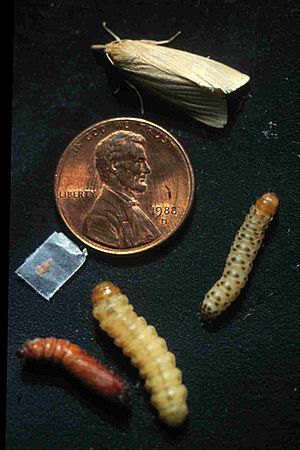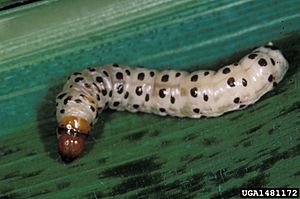Southwestern corn borer facts for kids
Quick facts for kids Southwestern corn borer |
|
|---|---|
| Scientific classification |
The southwestern corn borer (scientific name: Diatraea grandiosella) is a type of moth. Like many moths, it goes through a full life change called complete metamorphosis. This means it starts as an egg, then becomes a larva (a caterpillar), then a pupa, and finally an adult moth.
This moth can be found in many places. It lives in Mexico and across many states in the USA. These include Alabama, Arizona, Arkansas, Colorado, Illinois, Indiana, Kansas, Kentucky, Louisiana, Mississippi, Missouri, Nebraska, New Mexico, Oklahoma, Tennessee, and Texas.
The southwestern corn borer eats several kinds of plants. Its favorite foods include sugarcane, different types of sorghum, millet, and a plant called teosinte. It also loves to eat field corn, popcorn, and sweetcorn. Because it eats corn, it is a serious agricultural pest for farmers.
Contents
Life Cycle and Special Abilities
The southwestern corn borer has four main stages in its life cycle: egg, larva, pupa, and adult moth. The larva is a caterpillar that grows and eats a lot.
Sometimes, the larva can enter a special resting state called diapause. This happens when the days get shorter, which is called a precise photoperiod. During diapause, the larva stops growing and waits for better conditions. Hormones in its body control this growth and development.
How Farmers Control This Pest
Farmers use different ways to stop the southwestern corn borer from damaging their crops. One method is using pheromone traps. These traps release a special scent that attracts male moths, helping farmers know how many moths are around.
Farming Methods
Farmers can also plant their corn at certain times. They might choose corn types that grow quickly and ripen early. After harvesting, they often destroy any leftover plant parts. These methods help reduce the number of borers that can survive and reproduce.
Using Natural Help
Farmers sometimes use a special bacterium called Bacillus thuringiensis (often called Bt). This bacterium is a natural pesticide that is safe for many other animals. When the corn borer larvae eat plants treated with Bt, it makes them sick.
Another way to control pests is by using genetically engineered corn. This corn is made to be resistant to corn borers. Studies have shown that growing this type of corn can help farmers produce more corn.
Biological Control
Farmers can also use a method called biological control. This means bringing in natural enemies of the corn borer. For example, some insects are parasites of the borer larvae. These parasites lay their eggs inside the larvae, which then kills the borer.
Natural Enemies of Moths
Many animals like to eat moths and their larvae. At night, some bats and owls hunt adult moths. Other birds also feed on them.
Moths can also be eaten by some lizards, cats, dogs, rodents, and even some bears. The larvae of the southwestern corn borer can be attacked by certain types of wasps that are parasites.



